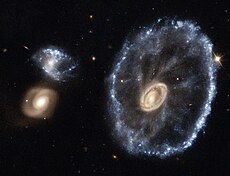Ring galaxy
A ring galaxy is a rare form of galaxy formed by the interaction of two galaxies. Ring-like structures also occur in other galaxy forms such as polar ring galaxies and some barred spiral galaxies .
Appearance
A characteristic feature of a ring galaxy is a thin, sometimes irregular, bright ring, many kiloparsecs in diameter, which lies in the plane of the galaxy. The blue color and lumpy structure of the ring show that it contains many young star formation areas. Sometimes one sees another compact galaxy in the vicinity of a ring galaxy, which was involved in its formation, but distinguishing such objects from random foreground or background galaxies requires a more detailed study of the individual case.
Emergence
Ring galaxies are created by a special case of the interaction of galaxies: A spiral galaxy is pierced by another fast-moving galaxy near its center, as if it were hitting the black of a target. As the intruder passes through the center of the spiral galaxy, its gravity adds to that of the core area of the spiral galaxy, and stars and gas further out in the spiral galaxy are thereby drawn inward. This additional force directed towards the center stops when the intruder has left the center of the spiral galaxy, stars and gas in the disk of the spiral galaxy recede outwards again.
Model calculations show that in such a case an outward-running compression wave in the spiral galaxy is excited. This is also visible in the already existing old stars, but it is particularly important that it leads to a compression of the interstellar gas of the spiral galaxy and thus to increased star formation in a ring running outwards.
Examples
Wagon wheel galaxy
Probably the best known ring galaxy is the wagon wheel galaxy in the constellation Sculptor . At 500 million light years, it is relatively distant and no longer listed in the NGC catalog .
At the center of the wagon wheel galaxy is a bulge similar to an elliptical galaxy . The ring of the wagon wheel galaxy has a diameter of 150,000 light years, is unstable, and moves away from the center at 340,000 km per hour. One of the two small structures on the left, two small galaxies near the wagon wheel galaxy, could be the intruder involved in the collision. The fact that the upper blue of the two galaxies also shows turbulence and many star formations suggests that it was.
The special thing about this galaxy are the ribbons of stars, the 'spokes' of the wagon wheel, which stretch from the center of the galaxy to its ring. In all likelihood, they are the earlier spiral arms of the disturbed Star Island. Another special feature are large clusters of gas on the outer edge of the main level. It is hoped that these gas accumulations will provide further information about the unusual shape of the wagon wheel galaxy.
AM 0644-741
AM 0644-741 , 300 million light years away, is a ring galaxy with an eccentric blue ring around the yellowish central region of the galaxy. We look at the main plane of your disk at an angle. The intruder who caused the ring formation has been identified, but is outside the area of the image shown. The small galaxy in the upper left is a background object. AM 0644-741 is located in the constellation Swordfish .
Your ring is 150,000 light years across. It contains many groups of hot (blue) young stars. That is the reason for the blue color of the ring. The compression wave that drives the ring outwards, compressed gas regions. This leads to the formation of the many young hot stars. At the captured time (picture) the ring is still expanding. According to theoretical studies, this expansion of the ring takes another 300 million years, after which it dissolves.
Another feature of the ring is the pink regions. These are thinner cloud formations made of ionized hydrogen ( HII areas ). They fluoresce from the ultraviolet radiation from the new hot stars.
Web links
- What is a ring galaxy? from the alpha-Centauri television series(approx. 15 minutes). First broadcast on Jan 5, 2003.
- ESO: Cosmic hit and run

